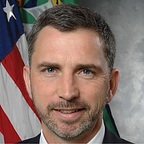Government is Beautiful
Government is beautiful. Really.
What is the alternative? Are there places with no government that you would want to live? Anarchy is NOT beautiful. It is dangerous. Life under anarchy is most assuredly consistent with Hobbes’ description in Leviathan: “nasty, brutish and short.”
But why does this phrase sound so surprising? Perhaps because for the last several decades the debate over the size, type and scope of government has been conflated with the existential question. And, frankly, if we want to make government more beautiful, we need to separate those two streams of debate. In fact, what makes government MORE beautiful is an on-going discussion, even an argument, over what form it should take.
In this sense, we should consider government like art. There is little debate — although some — about whether art is useful, important or beautiful. Few would spend any time arguing whether the idea, concept or execution of art in general is beautiful. Clearly, the discussion — just as it should be for government — is whether particular examples or endeavors are beautiful. Is a particular painting, dance routine or musical composition beautiful? What comprises that beauty is a matter of subjective and objective measures of skill, complexity, novelty or sensory satisfaction. It is rooted in cultural norms, upbringing, personal taste and progress. As it is with government. The debate should be over the beauty of the execution, or outcome, not the underlying activity.
At an abstract level, our own US government is quite beautiful. The three counterbalanced branches of our Federal government has roots evocative of classical art and religion — a clear expression of its origin during the era of western development known as the Age of Enlightenment. And like a well executed engineering project such as a bridge, it embodies the counterbalance of forces such as tension and compression with the political equivalents of checks and balances; advise and consent; and separation of powers. Few would argue that its outward manifestations, its buildings, monuments and institutions, are not quite frequently some of the most beautiful and timeless expressions of beauty in design wherever they are. For example, I recently visited a Depression-era post office on Canal Street in Manhattan that presented the unsuspecting visitor with a giant frieze representing speed, strength and progress. And my adopted hometown of Washington, DC, seat of our national government, is beautiful by design — even when it is dirty, incomplete or shot from unflattering angles, such as during the opening credits to “House of Cards,” its beauty can’t help but shine through.
That doesn’t mean it cannot be much, much more beautiful. The skepticism that greets the concept of government being beautiful has more to do with the way government processes work or interact with people as customers: a long, painful wait at the DMV; an application that is not clearly explained by its instructions; required support material that never seem to be fully detailed; and no on-going feedback. Government processes and interactions frequently leave their non-government counterparties feeling powerless, confused or uncertain. In fact, government-to-government processes often have the same qualities. Ask a friend or relative who works in government about human resources or acquisition processes and you will get an earful of the sort you might expect from someone who went to the local business licensing office.
These complicated, convoluted, unclear, non-transparent and decidedly NOT beautiful processes are not the product of malevolent forces. They are the outcome of complexity, inconsistent investment, necessary oversight, legislative mandate and the bureaucratic equivalent of geologic deposition of layer after layer of all of these things. To make government more beautiful in interacting with the people it serves we need to mine through these layers to more directly connect the agents of government with those people. The technology revolution of the last decade — the incredible combination of ubiquitous interconnected computing and communications — makes this connection faster, easier and more cost-effective than any other point in history. It is time to export the transformation that we have experienced in nearly every other form of transaction — from personal communication to retail shopping and entertainment — to our most vital civic institutions.
An emerging set of new companies have launched themselves into the void between expectation and the current reality. These firms, including my own, SeamlessDocs, are focused on leveraging the contemporary technological disruption to transform government business processes at their most fundamental level — where people and government interact at the point of information transfer. Others are working to use this data to support improved decision-making and service delivery. Still others are improving communications, program efficiency or transparency.
So, let’s stop simply bashing government and instead recognize the fundamental truth that government is beautiful. And with the application of new tech and improved processes it will be even more beautiful.
***
Daniel “Dan” Tangherlini
President | SeamlessDocs Federal
855.77.SEAMLESS
SeamlessGov.com
